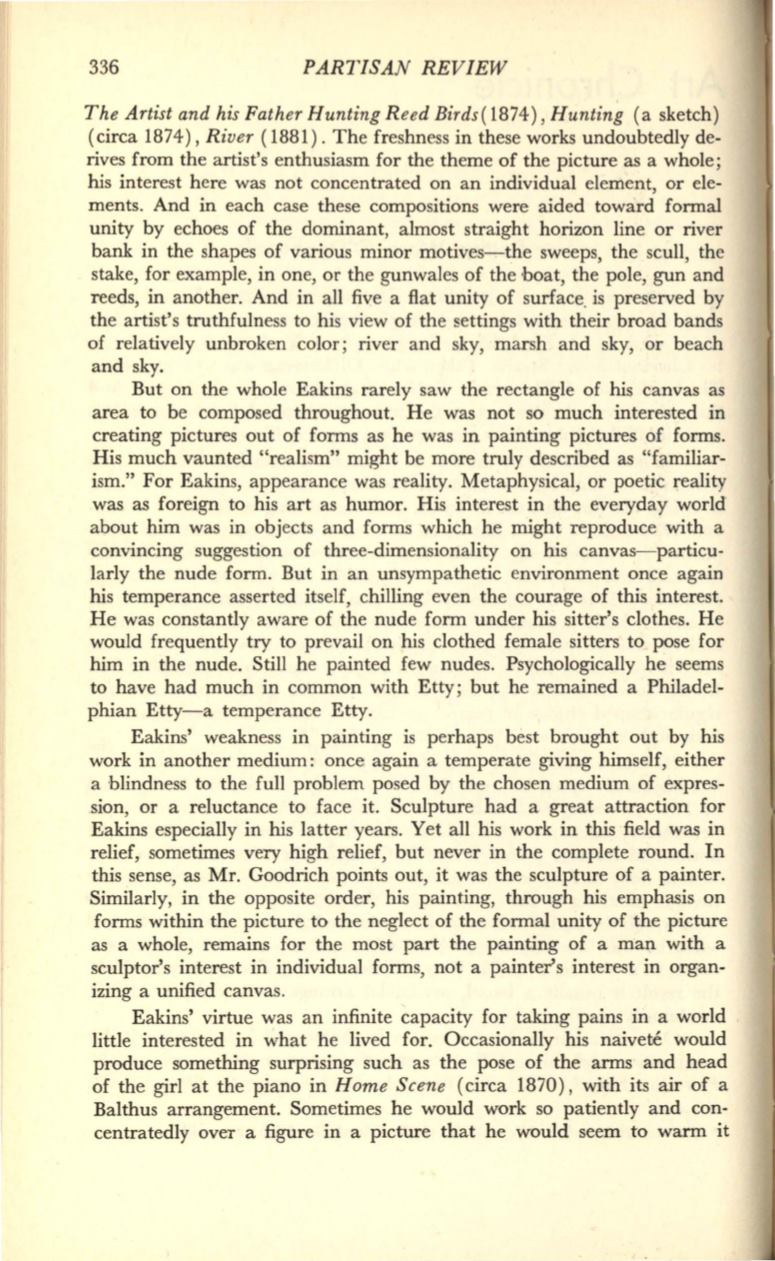
336
PARTISAN REVIEW
The Artist and his Father Hunting R eed Birds(
1874),
Hunting
(a sketch)
(circa 1874),
River
(
1881). The freshness in these works undoubtedly de–
rives from the artist's enthusiasm for the theme of the picture as a whole;
his interest here was not concentrated on an individual element, or ele–
ments. And in each case these compositions were aided toward formal
unity by echoes of the dominant, almost straight horizon line or river
bank in the shapes of various minor motives-the sweeps, the scull, the
stake, for example, in one, or the gunwales of the boat, the pole, gun and
reeds, in another. And in all five a flat unity of surface. is preserved by
the artist's truthfulness to his view of the settings with their broad bands
of relatively unbroken color; river and sky, marsh and sky, or beach
and sky.
But on the whole Eakins rarely saw the rectangle of his canvas as
area to be composed throughout. He was not so much interested in
creating pictures out of forms as he was in painting pictures of forms.
His much vaunted "realism" might be more truly described as "familiar–
ism." For Eakins, appearance was reality. Metaphysical, or poetic reality
was as foreign to his art as humor. His interest in the everyday world
about him was in objects and forms which he might reproduce with a
convincing suggestion of three-dimensionality on his canvas-particu–
larly the nude form. But in an unsympathetic environment once again
his temperance asserted itself, chilling even the courage of this interest.
He was constantly aware of the nude form under his sitter's clothes. He
would frequently try to prevail on his clothed female sitters to pose for
him in the nude. Still he painted few nudes. Psychologically he seems
to have had much in common with Etty; but he remained a Philadel–
phian Etty-a temperance Etty.
Eakins' weakness in painting is perhaps best brought out by his
work in another medium: once again a temperate giving himself, either
a blindness to the full problem posed by the chosen medium of expres–
sion, or a reluctance to face it. Sculpture had a great attraction for
Eakins especially in his latter years. Yet all his work in this field was in
relief, sometimes very high relief, but never in the complete round. In
this sense, as Mr. Goodrich points out, it was the sculpture of a painter.
Similarly, in the opposite order, his painting, through his emphasis on
forms within the picture to the neglect of the formal unity of the picture
as a whole, remains for the most part the painting of a man with a
sculptor's interest in individual forms, not a painter's interest in organ–
izing a unified canvas.
Eakins' virtue was an infinite capacity for taking pains in a world
little interested in what he lived for. Occasionally his naivete would
produce something surprising such as the pose of the arms and head
of the girl at the piano in
Home Scene
(circa 1870), with its air of a
Balthus arrangement. Sometimes he would work so patiently and con–
centratedly over a figure in a picture that he would seem to warm it


